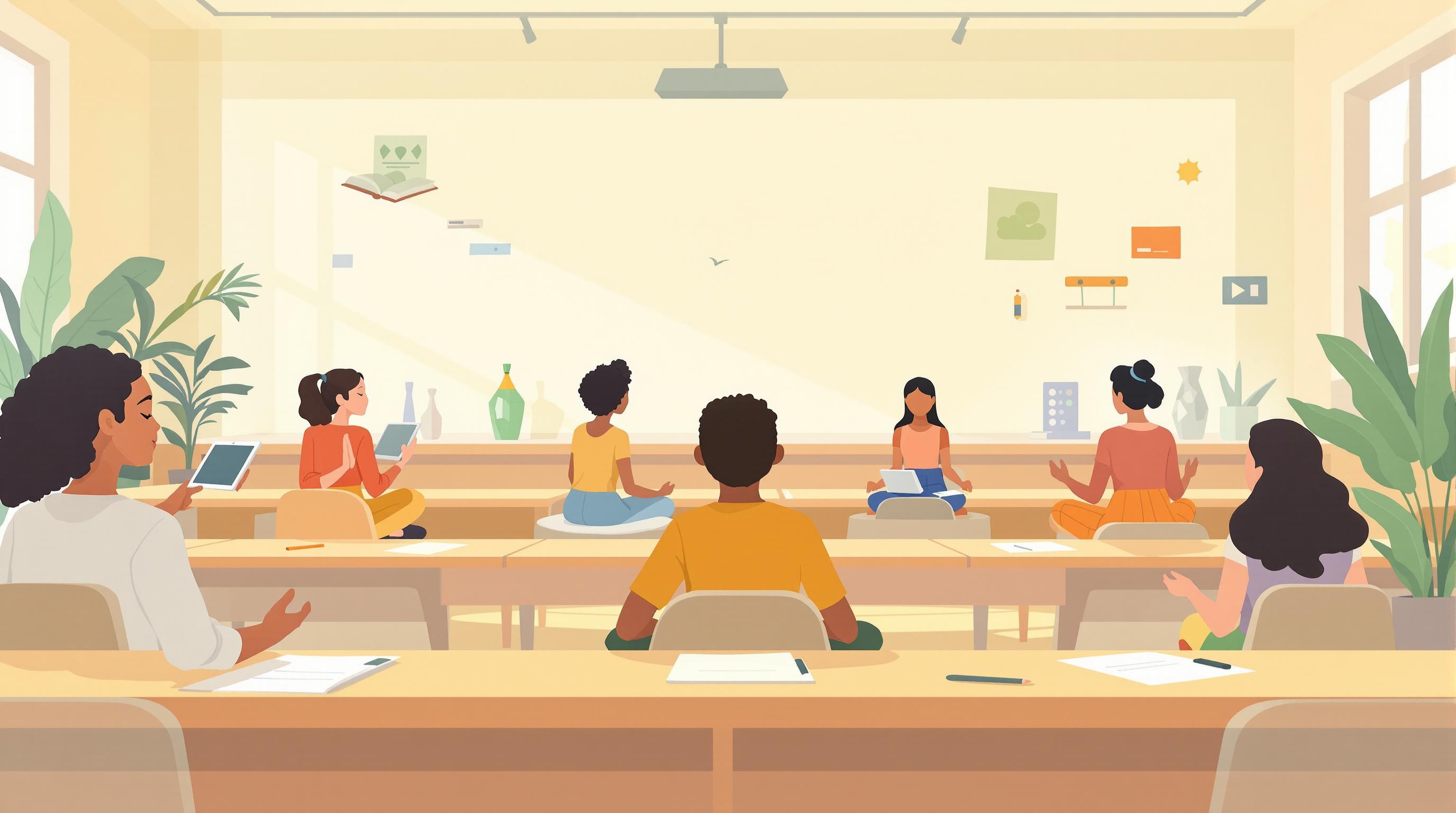Blended learning combines face-to-face teaching with online tools to create a more engaging and flexible learning environment. Here's what you need to know:
- Mixes traditional classroom methods with digital resources
- Allows students to learn at their own pace
- Keeps students interested through varied learning methods
- Makes education more accessible
- Provides quick feedback on student progress
Key blended learning methods:
- In-Person Teaching: Traditional lectures with digital enhancements
- Station Learning: Students rotate through different learning stations
- Self-Paced Learning: Students progress through online material independently
Using AI in blended learning:
- LessonBud: AI tool for creating assignments and managing classes
- AI-powered tools for custom learning materials and progress tracking
Steps to start blended learning:
- Set clear learning goals
- Plan lessons mixing online and in-person elements
- Use engaging content and quick feedback to keep students interested
- Start small and gradually expand
Common challenges and solutions:
| Challenge | Solution |
|---|---|
| Tech issues | Have offline backups ready |
| Student adjustment | Provide clear guidance and support |
| Engagement | Use interactive content and group projects |
| Progress tracking | Regular assessments for all work types |
Measuring success:
- Track academic performance, engagement, and attendance
- Gather student feedback
- Continuously adjust and improve your approach
Blended learning is effective because it personalizes education, increases flexibility, and enhances teacher-student connections while preparing students for the future.
Common Blended Learning Methods
Blended learning isn't a one-trick pony. There are several ways to mix online and in-person learning. Let's dive into some popular methods and see how they stack up.
In-Person Teaching Method
Think traditional teaching with a digital twist. The teacher leads the class, but online tools join the party.
Here's the scoop:
- Teachers do their thing face-to-face
- Digital tools spice up the lesson (interactive whiteboards, online quizzes)
- Students get real-time help from the teacher
This method shines for subjects that need lots of explaining or practice.
Station Learning Method
Imagine a classroom with learning "stations". Students hop from one to another, each offering a different learning flavor.
A typical setup might look like this:
| Station | What's Happening |
|---|---|
| 1 | Teacher's mini-lesson |
| 2 | Online practice or video lesson |
| 3 | Group project or chat |
| 4 | Solo work |
This keeps things fresh and caters to different learning styles.
Self-Paced Learning Method
This one puts students in the driver's seat. They cruise through material at their own speed, with teachers as their GPS.
The lowdown:
- Students access lessons online
- They can rewind tough concepts or fast-forward through familiar ones
- Teachers check in and offer a helping hand
It's a hit with students who like to take charge of their learning journey.
Comparing the Methods
Let's break it down:
| Method | Shines For | Tricky Bits |
|---|---|---|
| In-Person Teaching | Complex stuff, hands-on learning | Not much personalization |
| Station Learning | Different learning styles, keeping it interesting | Juggling classroom chaos |
| Self-Paced Learning | Independent learners, flexibility | Keeping students fired up |
Each method has its superpower. The trick? Picking the right one for your classroom and students.
"The station rotation model works for all ages, even the little ones in kindergarten. It's a lifesaver for tackling those big class size headaches."
Real-world win: Clintondale High School in Michigan went all-in on the flipped classroom model. The result? By year's end, their students were outperforming their peers in traditional classrooms. Now that's what we call leveling up!
Using AI Tools in Teaching
AI is changing how teachers work. It's like having a super-smart helper that never gets tired. Let's see how AI can make your teaching better and easier.
Getting Started with LessonBud

LessonBud is the new kid on the block. It's an AI tool made just for teachers. Think of it as your always-on digital teaching assistant.
Here's what LessonBud can do:
- Make fun assignments quickly
- Help you manage your class better
- Fit right into how you already work
- Give you good, cheap tools for planning lessons and organizing your class
"LessonBud positions itself as the first AI tool for teachers, aimed at significantly reducing their teaching workload." - LessonBud
Making Custom Learning Materials
AI isn't just about grading faster. It's about making learning fit each student. Here's how:
AI can write articles at different reading levels. This helps you teach students who learn at different speeds.
It can make quizzes that change based on how well a student is doing.
It can even come up with fun writing ideas to get students' creative juices flowing.
For example, ChatGPT can explain tricky math ideas in a way that fits how each student learns. This personal touch can really help students get it.
Checking Student Progress
AI tools are changing how we track how students are doing and give them feedback. Check this out:
| AI Tool | What It Does | How It Helps |
|---|---|---|
| EssayGrader | Grades essays super fast | You grade 95% faster |
| AI Rubric Generator | Makes detailed grading guides | You grade more fairly |
| ChatGPT | Gives quick feedback on writing | Students get help right away |
These tools save time and grade fairly. This means you can spend more time helping students one-on-one.
AI Tools and Their Uses
Let's look at some AI tools and how they can make your teaching better:
1. ChatGPT
ChatGPT can help you make lesson plans that fit what you need to teach. It can write examples for students to practice with. It can even help with research by summing up info.
This tool has over 70 AI helpers for making and checking lesson plans. More than 2.5 million teachers use it.
This free tool works with Google Docs, Slides, and YouTube. It helps make fun lessons and give good feedback.
4. Quizizz
Teachers in 90% of U.S. schools trust this tool. It makes fun quizzes and tests.
These tools are great, but they're here to help you teach, not to replace you. As Betty Chandy from Penn GSE says:
"Education is acquiring knowledge, skills, values, beliefs and habits. It is the process that matters more than the product."
Steps to Start Blended Learning
Want to jump into blended learning? Here's how to get going:
Setting Learning Goals
First up: clear targets. What's the end game for your students? Here's the deal:
- Get specific. Don't just say "better at math." Say "20% faster at multiplication."
- Make it trackable. Use tests, projects, or quizzes to see progress.
- Stick to the curriculum. Your goals should fit with broader education standards.
"Blended learning aims to boost student performance in ways we can measure. We use assessments to guide our teaching based on how students are doing."
Planning Your Lessons
Time to mix it up. Blend online and face-to-face teaching like this:
| In-Person | Online |
|---|---|
| Group talks | Video lessons |
| Hands-on labs | Online quizzes |
| Student presentations | Virtual simulations |
Start small. Try blending one lesson before you overhaul everything.
Keeping Students Interested
Engagement is crucial. Here's how to keep students hooked:
Mix up your content. Use videos, readings, and interactive stuff.
Get them talking. Set up online forums or group projects.
Give quick feedback. Tools like LessonBud can help you respond fast and personally.
Here's a real-world win: Los Altos School District in California uses Khan Academy for math homework. Kids watch videos at home, then teachers coach them in class. It keeps students engaged both online and in person.
Getting Started Checklist
Ready to launch? Check these boxes:
- Count your resources (computers, internet)
- Pick a blended learning style (like Rotation or Flipped Classroom)
- Find or make online content
- Plan a schedule with both online and in-person stuff
- Learn the tech you need
- Show students how it works
- Start small - one group or one unit
- Ask for feedback and make it better
sbb-itb-bb2be89
Solving Common Problems
Blended learning is great, but it's not without its challenges. Let's look at some common issues and how to fix them.
Fixing Tech Problems
Tech issues can derail your lesson plans. Here's how to handle them:
| Problem | Solution |
|---|---|
| Bad internet | Have offline content ready |
| Audio issues | Get a good conference mic |
| Video troubles | Use a 360-degree camera |
Start with simple tech when introducing online learning. It's less likely to overwhelm you and your students.
Helping Students Adjust
Blended learning can be a big change for students. Here's how to make it easier:
1. Show them the ropes
Walk students through the online platforms. Give them a quick guide they can use when they're stuck.
2. Set clear expectations
Tell students exactly how they should participate online and in-person.
3. Keep them engaged
Use digital quizzes and polls to keep students interested. Tools like Quizizz, used in 90% of U.S. schools, can make learning fun.
4. Encourage teamwork
Set up virtual study groups or buddy systems. It helps students feel connected and supported.
Problems and Solutions Guide
Here's a quick guide for common blended learning issues:
| Problem | Solution |
|---|---|
| Students ignoring online work | Make assignments that matter |
| Low student engagement | Use games and interactive content |
| Hard to track progress | Do regular assessments for all work |
| Communication gaps | Set up multiple ways to talk with students |
| Students feeling isolated | Use group projects and virtual hangouts |
The key to good blended learning? Be flexible and always try to improve. When you hit a snag, see it as a chance to make your teaching even better.
"Education is acquiring knowledge, skills, values, beliefs and habits. It's the process that matters more than the product." - Betty Chandy, Penn GSE
Measuring Success
Blended learning success isn't just about grades. It's about seeing real progress in student learning and engagement. Here's how to track results and improve your teaching.
Tracking Results
To gauge blended learning effectiveness, look at these key areas:
| Area | What to Check |
|---|---|
| Academic Performance | Test scores, project quality, skill improvement |
| Student Engagement | Participation rates, task time |
| Attendance | In-person and online rates |
| Learner Satisfaction | Survey feedback, informal check-ins |
Mix numbers with qualitative measures:
- Use pre and post quizzes to show knowledge increase
- Do regular assessments at 3 months, 6 months, and 1-2 years
- Calculate ROI: (Benefit – Cost) x 100 / Cost
"Decision-makers seek programs with visible, measurable impact and maximum return on investment."
Real-world example: The University of California, Irvine saw a 20% jump in student retention rates after trying a blended model.
Making Things Better
Put your data to work:
1. Analyze the data
Spot patterns. Are students struggling with certain topics? Is engagement dropping? Use tools like LessonBud to help.
2. Get student feedback
Ask students what's working and what's not. Their insights are valuable.
3. Adjust your approach
Tweak your methods based on what you've learned. Maybe you need more face-to-face time for complex topics.
4. Keep experimenting
Try new tools and techniques. Khan Academy's personalized learning paths have boosted academic achievement. Could this work for you?
5. Share your findings
Talk with other teachers. Learn from each other's successes and challenges.
Improving your blended learning approach is ongoing. As Joel Asiala, Principal of Public Schools of Calumet, Laurium, and Keweenaw, says:
"If you don't know what's going on with kids behind the scenes, you won't be successful in teaching them. We need to understand kids and what they're dealing with personally to reach them academically."
Wrap-Up
Blended learning mixes face-to-face teaching with online tech. Here's what we've learned:
Personalization Power
Blended learning tailors education to each student. How? By using tech to:
- Give quick feedback
- Customize coursework
- Let students learn at their own speed
It works. UC Irvine saw 20% more students stick around after going blended.
Flex and Access
Blended learning breaks down walls. Students can learn anytime, anywhere. This helps:
- Working pros juggling jobs and school
- Students with different learning styles
- Those needing extra help or bigger challenges
Money Matters
Schools and companies save cash with blended learning. Ernst & Young cut training costs by 35%. They shrunk 2,900 classroom hours to:
| Learning Type | Hours |
|---|---|
| Web | 700 |
| Distance | 200 |
| Classroom | 500 |
That's 53% less training time. Not bad.
Teachers Still Rule
Tech doesn't kick teachers out. It makes them stronger. Dave Levin from KIPP says:
"Without top-notch teachers, blended learning won't work or last."
With blended learning, teachers can:
- Zero in on student needs
- Help where it counts
- Cook up new teaching tricks
What's Next?
Blended learning's here to stay. Arne Duncan, ex-U.S. Education Secretary, nails it:
"Old-school factory education doesn't cut it anymore. We need schools that get kids ready for college and careers, personalize teaching, and use tech smartly."
Blended learning's not perfect, but it's a step in the right direction. It's all about finding that sweet spot between tech and human touch.
FAQs
Why blended learning is more effective?
Blended learning mixes traditional classroom teaching with online learning. It's more effective because:
It fits different learning styles. Some students learn better in person, others online. Blended learning caters to both.
It keeps things interesting. Switching between online and in-person activities prevents boredom.
It helps teachers stay organized. Digital tools make it easier to track how students are doing.
It improves teacher-student connections. There are more ways to communicate and interact.
It's flexible. You can use blended learning for pretty much any subject or teaching style.
Here's a quick comparison:
| Aspect | Traditional Learning | Blended Learning |
|---|---|---|
| Learning speed | Same for everyone | Personalized |
| Study materials | Just classroom stuff | Classroom + online resources |
| Getting feedback | Takes time | Often right away |
| Where and when | Fixed times and places | Flexible |
The U.S. Department of Education found some cool things about blended learning:
- Students become more independent
- They're more excited to learn
- They can access advanced material
- It prepares them better for college
"Student control is key. Without it, blended learning is just a teacher showing online stuff on a big screen." - Clifford Maxwell, Education Researcher
Real-world example: Ernst & Young cut training costs by 35% using eLearning. They also made their training more consistent and scalable. This shows blended learning works well beyond just schools.


